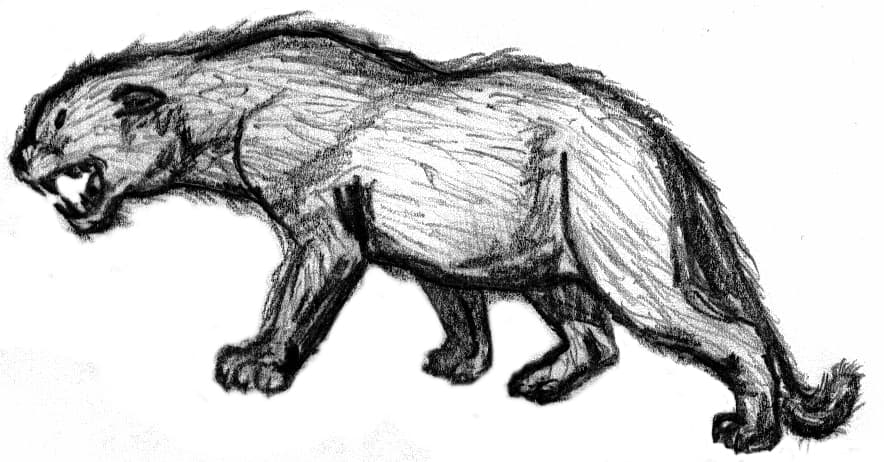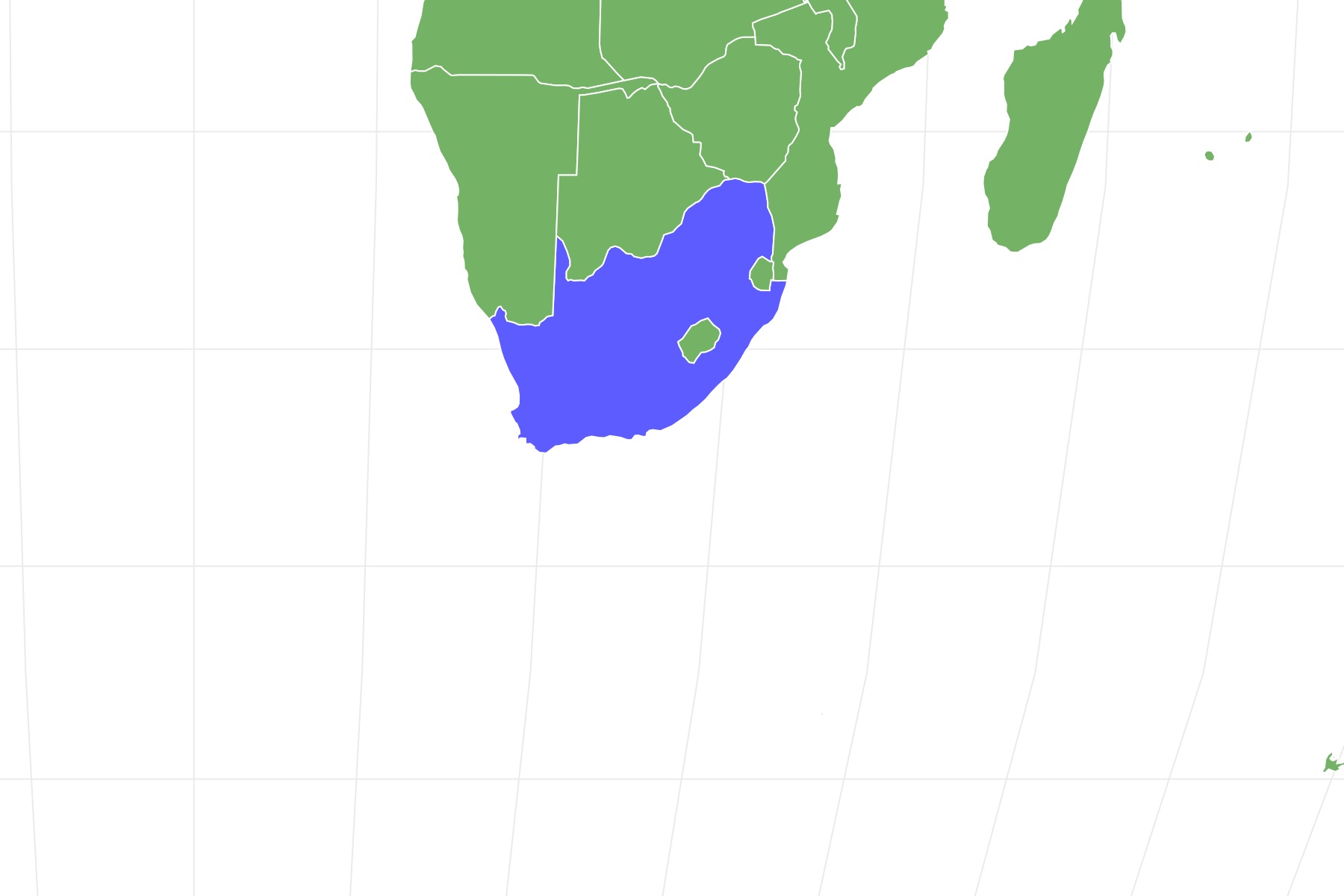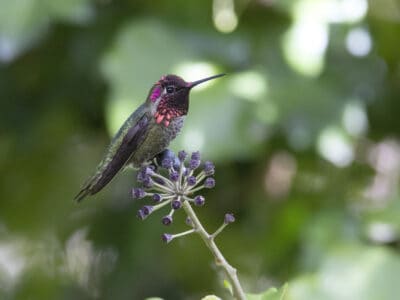Dinofelis
Advertisement
Dinofelis Scientific Classification
Read our Complete Guide to Classification of Animals.
Dinofelis Conservation Status
Dinofelis Facts
- Diet
- Omnivore
Dinofelis Physical Characteristics
View all of the Dinofelis images!
Introduction
The dinofelis is a genus of saber-toothed cats that belonged to either the Smilodontini or Meailurini tribe. These extinct creatures inhabited parts of Europe, Africa, Asia, and North America between 5 to 1.2 million years ago. They existed during the early Pliocene and Pleistocene Periods. Dinofelis were around the same size and build as a modern leopard or lion.
Description & Size

The dinofelis is believed to have lived a solitary life and hunted at night, much like our modern-day
leopards
.
©884 × 462 pixels, file size: 208 KB, MIME type: image/jpeg – License
This large cat is part of groups either as a large or small dinofelis species. The appearance of the various species would differ. Some species only reached 3 feet long, while others grew to 5 feet long and weighed up to 250 pounds.
Dinofelis had a medium-sized build and had prominent saber teeth protruding from their powerful jaws. They were likely found in forest-like habitats due to their build and size and had spotted or striped coats. Fossils and reconstructed pictures of the dinofelis indicate that they were very powerful cats. They weighed slightly more than the modern big cats and had less prominent teeth than actual saber-toothed cats.
Paleontologists also refer to the cat as a “false saber-tooth” because of their distant relation to actual Smilodon (saber-toothed cats). Their large weight and robust build did not make it the fastest runner. It is likely that they were ambush hunters instead.
Some depictions of the dinofelis show that it has a medium-length, fluffy coat lined with stripes, a small tail, and a head, along with a muscular and well-built body. Their canines stick out of their mouth. They lack the deep ribcage seen in fast big cats such as cheetahs.
Diet – What Did The Dinofelis Eat?
The dinofelis was a carnivore and ambush hunter. They preyed on herbivorous animals that ate grass and vegetation as their main diet and rarely attacked other predatory animals. Climbing into trees, they would wait for unsuspecting prey to fall within their view from the tree. They would then leap onto the prey and make it their next meal.
The dinofelis likely preyed on many different grass-feeding species, like baboons and antelope. They seemed to have eaten both primates and hominids and attacked our human ancestors as a source of food. Dinofelis ate animals and hominids such as mammoth calves, mastodons, giraffids, zebras, and Homo habilis.
Fossils of both baboons and dinofelis are found in a natural trap in South Africa. This indicates to paleontologists felt they were lured in by trapped prey. There is also evidence that the dinofelis hunted Australopithecus africanus and extinct hominids. It is known due to fossils found with the same shaped canine indentations in the skull.
The larger species would prefer large prey to hunt and eat. Smaller species went for small prey like baboons. The robust forelimbs of the dinofelis showed that their strong muscle structure allowed them to wrestle with their prey. They did not risk dental injuries to inflict a wound.
Habitat – When and Where It lived
Dinofelis lived around 5 to 1.2 million years ago, during the early Pliocene and Pleistocene Periods. Fossils indicate their geological location is in parts of Africa (most notably South Africa), Asia, Europe, and North America. They lived in forest environments with dense vegetation.
It is also possible that they inhabited wetlands and riverine bush habitats, but forestry habitats were a preference. Hunting would be easier for the dinofelis in dense plant growth with trees. This allowed them to ambush their prey effectively rather than hunting in wide open lands. The dinofelis is known to live a solitary life and hunt at night, much like our modern-day leopards.
It is possible that the dinofelis was able to adapt to a mixed environment, and it is possible that some species could adapt to live and hunt and open environments such as dry bushvelds in Africa. However, this is species dependent.
Threats And Predators
Dinofelis was a predator itself that hunted during the night and early mornings and evenings. Some species of dinofelis were also found deceased in places where their prey was trapped, making it possible the dinofelis felt the lure of trapped animals and couldn’t escape. It is unclear what predators the dinofelis would have faced during its period, but other predatory animals or large mammoths may have been able to kill the dinofelis.
Discoveries and Fossils
The first fossil discoveries were in 1924 by Otto Zdansky. The name of this prehistoric big cat translates to “terrible cat” because the belief is it ate our human ancestors.
The fossils from this genus varied according to the species. Some species had a large conical upper canine which set it aside from other species and it had not yet been reported in North Africa. The features of the fossil found resembled the Siwalik species better than other African ones.
Fossils have been found in South Africa where they found fossils alongside baboons. Two specimens examined by Serge Legendre and Claudia Roth for their body mass weighed around 190 pounds and the other one was 69 pounds, which showed the difference in the different dinofelis species sizes.
Fossilized canine teeth were more flattened and longer than our modern big cats, but much smaller than true saber-toothed cats. Carbon isotope ratios in specimens from Swartkrans showed that the dinofelis preferred to hunt grazing animals like herbivores or omnivores. Although the carbon isotope ratio proved little in terms that the dinofelis ate hominids, fossil evidence showed that some dinofelis may have attacked them.
Extinction – When Did It Die Out?
The dinofelis went extinct 5 to 1.2 million years ago. They only lived during the early Pliocene and Pleistocene Periods and went extinct shortly after. It is believed that the dinofelis went extinct due to sudden habitat changes and climate change. They seemed to go extinct before the Pleistocene extinction. A possible theory for the dinofelis extinction of an entire genus is due to the cycles of the ice age waning and waxing that caused habitat and climate changes.
However, certain experts are wondering how none of the species in the dinofelis genus could have adapted and were all wiped out completely. Instead, there is a possibility that the dinofelis couldn’t compete with other carnivores that had more advantages. If the dinofelis were outcompeted by new evolving species, it is understandable how they would die off due to the environmental and equilibrium changes.
The development of other carnivorous cats outcompeted the dinofelis in its own habitat. A mixture of environmental changes, climate change, human interference, and even major faunal changes that occurred during the time of the dinofelis extinction could be contributors.
Similar Animals to The Dinofelis
The dinofelis mainly resembles a large wild cat, much like the ones we see today. They also share similarities with other prehistoric wildcats.
- Lion- A large cat from the Panthera genus that is native to Africa. They share a similar body structure and hunting abilities to the dinofelis.
- Leopard- One of the five extant species in the Panthera genus and shares similar coat patterns and behaviors to the dinofelis.
- Meganterion- A large prehistoric cat that resembled the dinofelis and lived around the same time. They were likely competitors because both animals inhabited similar environments.
Dinofelis FAQs (Frequently Asked Questions)
When was the dinofelis alive?
The dinofelis lived during the early Pliocene and Pleistocene Period between 5 to 1.2 million years ago.
How big was the dinofelis
There were several different species in the dinofelis genus, and they were grouped as smaller or larger dinofelis species. The smaller species ranged from 2.5 to 3 feet in size, whereas the larger species could grow up to 5 feet long and weight 250 pounds. Some of the smaller species weighed around 69 pounds according to the specimens that have been found.
What did the dinofelis eat?
The dinofelis was a carnivore and ambush hunter. They would leap from trees or under plants to attack their prey. The dinofelis mainly ate grazing animals, such as antelope, baby elephants, zebras, and giraffids. They also ate omnivores like baboons, baby mammoths, and mastodons. There is a possibility that the dinofelis ate hominids according to tooth indentations in the hominid’s skulls and carbon isotope ratio testing.
How many sepcies of dinofelis are there?
Dinofelis is used to describe a genus of 10 species of false sabre-toothed cats.
Thank you for reading! Have some feedback for us? Contact the AZ Animals editorial team.
Sources
- Wikipedia , Available here: https://en.wikipedia.org/wiki/Dinofelis
- New dinosaurs , Available here: https://www.newdinosaurs.com/dinofelis/
- Quora , Available here: https://www.quora.com/Why-did-dinofelis-get-extinct

















